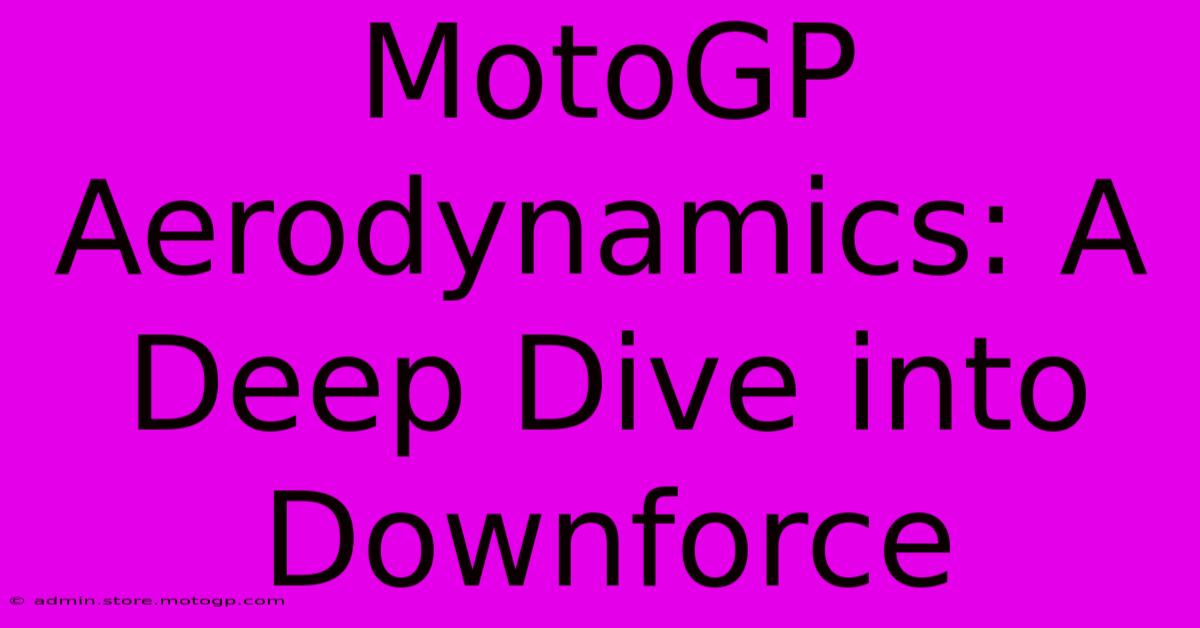MotoGP Aerodynamics: A Deep Dive Into Downforce

Table of Contents
MotoGP Aerodynamics: A Deep Dive into Downforce
MotoGP racing is a relentless pursuit of speed, and a crucial element contributing to this speed is aerodynamics. While horsepower is king, the ability to maintain grip and stability at breakneck speeds relies heavily on generating sufficient downforce. This article delves into the intricate world of MotoGP aerodynamics, focusing specifically on how downforce is achieved and its impact on rider performance.
Understanding Downforce in MotoGP
Downforce, in simple terms, is the aerodynamic force that pushes a motorcycle towards the track surface. Unlike lift, which pushes upwards, downforce is vital for high-speed cornering and braking. The higher the downforce, the greater the grip the tires have on the track, allowing riders to push harder and faster through corners without losing control. This translates directly to faster lap times and ultimately, victory.
How is Downforce Generated?
MotoGP bikes achieve downforce through carefully designed aerodynamic components. These include:
-
Wings: The most visible elements, these winglets generate downforce by creating a pressure differential. Air flows faster over the curved upper surface of the wing, creating lower pressure, while slower airflow under the wing creates higher pressure. This difference pushes the wing – and consequently the bike – downwards. The number, shape, and placement of these wings are constantly being refined to optimize downforce.
-
Fairings: The entire fairing, or bodywork, of the motorcycle is designed to manage airflow. Smooth surfaces minimize drag, while strategically placed curves and channels manipulate airflow to enhance downforce and improve stability.
-
Underbody Aerodynamics: The area underneath the bike is equally critical. Tunnels and diffusers under the bike accelerate airflow, creating a low-pressure zone that sucks the bike towards the track. This contributes significantly to overall downforce.
-
Ride Height: Even subtle adjustments to the ride height of the motorcycle can significantly impact downforce generation.
The Impact of Downforce on MotoGP Performance
The benefits of downforce in MotoGP are multifaceted:
-
Increased Cornering Speed: Greater downforce translates directly into higher cornering speeds. Riders can lean further and brake later without losing traction, shaving precious milliseconds off their lap times.
-
Enhanced Stability: Downforce keeps the bike planted to the track, improving stability under acceleration and braking, reducing the risk of high-side or low-side crashes.
-
Improved Braking Performance: With more grip due to increased downforce, riders can brake later and harder, entering corners at higher speeds while maintaining control.
The Constant Evolution of MotoGP Aerodynamics
Aerodynamic development is a continuous arms race in MotoGP. Teams employ sophisticated Computational Fluid Dynamics (CFD) simulations and wind tunnel testing to refine their designs. They constantly experiment with new wing designs, fairing shapes, and underbody configurations in an effort to extract even more downforce while minimizing drag.
The Future of Downforce: We can expect to see further advancements in MotoGP aerodynamics, likely involving more sophisticated and integrated aerodynamic solutions. The pursuit of optimal downforce is an ongoing quest for improved performance and a defining factor in the quest for victory.
Keywords:
MotoGP, Aerodynamics, Downforce, Wings, Fairings, Underbody Aerodynamics, Cornering Speed, Stability, Braking Performance, CFD, Wind Tunnel, MotoGP Technology, Motorcycle Racing, High-Speed Cornering, Grip, Racing Technology, Motorcycle Aerodynamics, Winglets, Ride Height, Pressure Differential
This article aims to provide comprehensive information about MotoGP aerodynamics with a focus on downforce, incorporating relevant keywords for better search engine optimization. Remember that constant updates and fresh content are vital for maintaining a strong online presence.

Thank you for visiting our website wich cover about MotoGP Aerodynamics: A Deep Dive Into Downforce. We hope the information provided has been useful to you. Feel free to contact us if you have any questions or need further assistance. See you next time and dont miss to bookmark.
Featured Posts
-
Moto2 Motorcycles The Future Of Racing
Feb 19, 2025
-
Race Bikes For Sale The Speed You Crave
Feb 19, 2025
-
Cota Lot H Making Life Easier
Feb 19, 2025
-
Invest In Speed Moto Gp Motorcycle Awaits
Feb 19, 2025
-
The Complete Guide To Cota F1 General Admission
Feb 19, 2025
